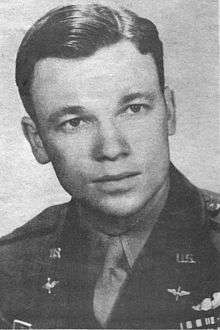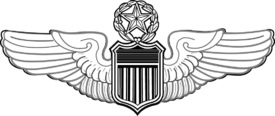John B. England
| John Brooke England | |
|---|---|
 | |
| Nickname(s) | “Johnny” |
| Born |
January 15, 1923 Caruthersville, Missouri |
| Died |
November 17, 1954 (aged 31) Toul-Rosières Air Base, France |
| Allegiance | United States of America |
| Service/branch |
|
| Years of service | 1942 – 1954 |
| Rank | Lt Col |
| Commands held |
362nd Fighter Squadron 389th Fighter-Bomber Squadron |
| Battles/wars | Korean War |
| Awards |
Silver Star Distinguished Flying Cross (5) Air Medal (15) |
John Brooke England (15 January 1923 – 17 November 1954) was a World War II fighter ace in the 357th Fighter Group and a career fighter pilot in the United States Air Force.
Biography
He was the son of Bidker H. and Pearl J. England of Caruthersville, Missouri. After graduating from Caruthersville High School on 16 May 1940, he worked as a bookkeeper and later he marketed various agricultural commodities. Growing up on the banks of the Mississippi River, his favorite hobby was fishing.
After the war started, he enlisted in the US Army on 1 April 1942. He was accepted into aviation cadet training and was sent to Yuma, Arizona where his flight instructor was future U.S. Senator and presidential candidate Barry Goldwater. He completed his flying training on 9 March 1943. He was then commissioned as a 2nd Lieutenant and received his pilot’s wings on 10 March 1943.[1]
After this training, he was assigned to the 362d Fighter Squadron of the 357th Fighter Group which was then flying the P-39 Airacobra. The 357th moved to Santa Rosa, California and then moved for additional training to Oroville, California in August 1943. After additional moves and training in other states, the personnel of the 357th boarded the RMS Queen Elizabeth and sailed from New York City on 23 November 1943.
World War II
The unit was assigned to RAF Leiston and after transitioning to the P-51 Mustang, they flew their first combat mission on 11 February 1944. John was promoted to 1st Lt. on 26 October 1943 and by the time he was promoted to Captain on 28 April 1944 he already had 6.5 aerial credits. After his first victory on 8 March 1944, he attained the status of “Ace” in only forty-eight days.
He took command of the 362d Fighter Squadron on 25 August 1944 and continued as the squadron commander until 8 April 1945. He was promoted to Major on 4 December 1944 and continued to fly combat sorties achieving his last aerial victory on 14 January 1945 for a total of 17.5 enemy aircraft destroyed in flight.
Summary of Enemy Aircraft Damaged/Destroyed
| Date | Location | Air/Ground | Number | Type | Status |
|---|---|---|---|---|---|
| 8 March 1944 | Near Steinhuder Meer (Lake), Germany | Air | 1 | Me-109 | Destroyed |
| 16 March 1944 | 20 miles south of Stuttgart, Germany | Air | 1 | Me-110 | Destroyed |
| 11 April 1944 | 20 miles northeast of Magdeburg, Germany | Air | 0.5 | Me-109 | Destroyed |
| 13 April 1944 | West of Mannheim, Germany | Air | 1 | FW-190 | Destroyed |
| 24 April 1944 | South of Munich, Germany | Air | 3 | Me-110 | Destroyed |
| 27 May 1944 | North of Strasbourg, France | Air | 1 | Me-109 | Damaged |
| 18 August 1944 | 20 miles northeast of Paris, France | Air | 0.5 | Me-109 | Destroyed |
| 13 September 1944 | South of Nordhausen, Germany | Air | 2.5 | Me-109 | Destroyed |
| 6 October 1944 | 20 miles northwest of Berlin, Germany | Air | 1 | Me-109 | Damaged |
| 6 October 1944 | 20 miles northwest of Berlin, Germany | Air | 2 | Me-109 | Destroyed |
| 27 November 1944 | South of Magdeburg, Germany | Air | 4 | FW-190 | Destroyed |
| 14 January 1945 | 20 miles northwest of Berlin, Germany | Air | 1 | Me-109 | Destroyed |
| 25 January 1952 | Korea | Air | 1 | Mig-15 | Damaged |
- All information on enemy aircraft damaged and destroyed is from Stars and Bars.[1]
After the war, Major England stayed in the Air Force. By 1949 he was promoted to LtCol and was given command of the Air Force's cadet training school at Nellis AFB, Nevada.
On 5 June 1949, he married Marilyn Ruth Boswell and they had three children.
During this time he formed a flight demonstration team called "The Red Devils", flying World War II-era P-51 Mustangs painted an all-over red. The team was short-lived, because the Mustangs and LtCol England were needed for service in Korea.
He served briefly in the Korean war flying six combat missions and on 20 February 1951, he was promoted to Lt Col.[1] In October 1953, he was assigned to Alexandria Air Force Base in Alexandria, Louisiana as commander of the 389th Fighter-Bomber Squadron where he flew the F-86 Sabre. The squadron deployed to Toul-Rosières Air Base, France in the fall of 1954. From Toul, he flew a mission for gunnery practice near Tripoli, Libya. He was then returning to Toul from Marseille, France on 17 November 1954. Due to bad weather and low visibility, he made several attempts to land and on his final approach his engine flamed out due to lack of fuel. As he attempted to land without power he was killed while trying to avoid a barracks building. For this selfless act, Alexandria AFB was renamed England Air Force Base.
He was the leading ace of World War II from Missouri and England City Park in Caruthersville, Missouri has a memorial in his honor. Part of the inscription on the plaque reads "This memorial of Colonel England is dedicated to and represents the highest tradition of American fighting men lost in wars fought for the preservation of our freedoms."
Col. England was buried at Arlington National Cemetery on 30 November 1954.
Awards and decorations
| Silver Star | |
| Distinguished Flying Cross with 3 oak leaf clusters. | |
| Air Medal With 14 oak leaf clusters | |
| Air Medal with 1 oak leaf cluster (second ribbon required for accouterment spacing) | |
| Air Force Presidential Unit Citation with 1 oak leaf cluster | |
| Army Good Conduct Medal | |
| American Campaign Medal | |
| European-African-Middle Eastern Campaign Medal | |
| World War II Victory Medal | |
| Army of Occupation Medal | |
| National Defense Service Medal | |
| Korean Service Medal | |
| French Croix de guerre with silver star | |
| United Nations Korea Medal | |
| Korean War Service Medal | |
